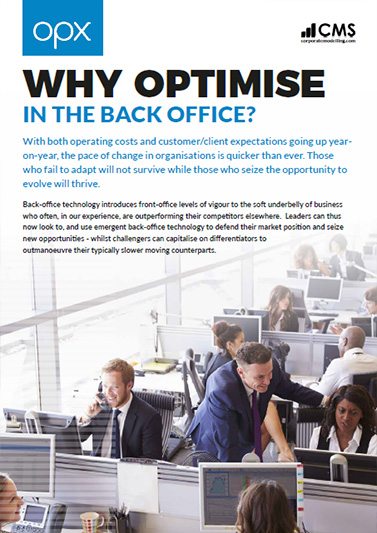Workforce productivity is usually at the top of every organisations priorities. But when it comes to a contact centres back office, being able to measure performance and productivity isn’t always as straightforward as it is for the front office and customer facing agents.
In most organisations, back office environments perform operations which are vital to keeping the wheels of the business turning. However, even though it has been established that the back office forms a major part of the customer experience, a percentage of contact centre workload is directly caused by issues in the back office. These issues can include incomplete or incorrect applications and late responses. All of these can cause a customer to get in touch – either by phone, email, chatbots etc. highering the cost to your contact centre.
As contact centre management work tirelessly year on year to reduce the costs, the back office is often overlooked – left to develop their own process and employee planning strategies.
Although companies do invest in technology to automate their back office workflows, they often forget about optimising employee productivity and proficiency at the same time. As tasks in the back office are more complex than the front, requiring different skills and certain personality traits, it’s important to focus on fully utilising the staff you currently have.
So how can back-office operating departments do this?
Productivity in the back office can be measured by the true production time of employees. Most organisations struggle to measure this, and this is where a back office solution can help.
Here are some familiar challenges a back office solution should help an organisation address:
- Prioritise, track and manage workloads on an individual, team or multi-site basis
- Monitor employee progress with departmental insight and any missing coaching required for each employee
- Track handle time (by transaction) and overall productivity in real-time to understand utilisaton and current demand
- Predict drops or spikes in work volume to calculate number of required employees in order to fulfill SLA’s.
- Effective distribution of work, avoiding staff ‘cherry picking’ their next job
- Reduce overtimes by managing backlogs
- Source real productivity by collecting data on applications being used and the steps taken by an employee to complete the tasks
If you can say your back office is able to address all of these aspects, then you’re on the right track. If, like many, you can only tick off a couple, then you could be missing out on major cost savings.
How to measure productivity – the tool and the strategy
Back offices are often siloed with many teams and departments working separately and each using disparate systems. Within the back office, mangers are usually restricted by lack of real-time information which would help them measure true production time.
The easiest way to measure performance across the back office is to implement an integrated back office management solution. But let’s not forget, along with the technology, you need the strategy.
Here are 4 KPI’s you need to keep in mind when measuring productivity in your back office:
- Case Reopen Percentage: If the backlog in your back office is growing, consider how many existing cases might be re-opened. This will affect your employee’s productivity. Knowing and understanding the case reopen rate is important in helping you identify:
- Cases that require extra effort (and perhaps extra help for that specific agent)
- Which employees require additional training to complete cases quicker and effectively
Tip for identifying broken work flows: Back office solutions will allow you to report on Quality assurance and failure demand helping you identify processes and activities that aren’t working and also how individuals are performing. (More info on this in number 4’s tip – ‘tip for back office quality’)
- Productivity: How many of your employees are meeting your utilisation and productivity mark? Are they using their time effectively and how long is it taking them to complete certain processes? Understanding these timescales can show you where the gaps are and where you need to spend more time training. Why not consider biweekly meetings reflecting on productivity, achieved SLA’s, case reopen and case closed percentage rates? By having meetings that review all your back office KPIs, you will understand exactly what happened and which variables were affected.
Tip for productivity: Some back office solutions have a ‘get next’ option. This allows agents to select the next work item from the queue based on their skills level, SLA, business priorities and other criteria set by the team leader. This avoids staff ‘cherry picking’ work/simple cases.
- Case Closed Percentage: Your back-office team have a list of tasks they need to finish. Keeping track of the percentage of cases that are completed daily, correctly and on time is vital. Don’t forget to also then compare this to your backlog of work. This will help you see if any changes need to be made.
Tip for back office visibility: Back office solutions will provide you with dashboards showing visibility on productivity, utilisation and SLA’s. These solutions may have a re-usable widget where reports and dashboards can be easily created, customised, stored and run, providing real-time and historic information based on teams, departments and processes. Data from these reports can also be easily fed into third party business information and spreadsheets applications.
- Case Quality Score: Each customer case has a direct impact on customer experience within your organisation and, should be monitored for quality and compliance purposes. This KPI is really important. It helps you keep track of the number of employees mishandling cases resulting in cases being re-opened or even investigated. Being able to identify these cases means cutting back on duplicate work. This in turn, will cut down your backlogs, costs and improve employee productivity.
Tip for back office quality: With a back office solution, you will be able to collect samples of completed work to examine how the item progressed through the process/case. For example, for a letter, call or email, you will be able to analyse how it was handled, how long it took and what actions were taken to bring the case to completion. Quality scores can then be collected and measured to give you an idea of what can be improved throughout the customer journey.
Related Articles
Do You Lack Visibility Of Productivity And Effectiveness In Your Back Office?
The Future of Front and Back Office Workforce Blending (White paper)







 Thank you for your interest in our whitepaper. You can download Workforce Optimisation vs Workforce Management by clicking the button below.
Thank you for your interest in our whitepaper. You can download Workforce Optimisation vs Workforce Management by clicking the button below. Thank you for your interest in our case study. You can download the HCL IBS Case Study by clicking the button below.
Thank you for your interest in our case study. You can download the HCL IBS Case Study by clicking the button below. Thank you for your interest in our case study. You can download the ReAssure Case Study by clicking the button below.
Thank you for your interest in our case study. You can download the ReAssure Case Study by clicking the button below. Thank you for your interest in our case study. You can download the Student Loans Case Study by clicking the button below.
Thank you for your interest in our case study. You can download the Student Loans Case Study by clicking the button below. Thank you for your interest in our case study. You can download the Principality Building Society Case Study by clicking the button below.
Thank you for your interest in our case study. You can download the Principality Building Society Case Study by clicking the button below. Thank you for your interest in our whitepaper. You can download WorkFlow vs WorkForce Management by clicking the button below.
Thank you for your interest in our whitepaper. You can download WorkFlow vs WorkForce Management by clicking the button below. Thank you for your interest in our whitepaper. You can download Homeworking in Financial Services Operations by clicking the button below.
Thank you for your interest in our whitepaper. You can download Homeworking in Financial Services Operations by clicking the button below. Thank you for your interest in our whitepaper. You can download Workforce Optimisation for the Back Office by clicking the button below.
Thank you for your interest in our whitepaper. You can download Workforce Optimisation for the Back Office by clicking the button below. Thank you for your interest in our whitepaper. You can download Operational Workforce Management: Build or Buy? by clicking the button below.
Thank you for your interest in our whitepaper. You can download Operational Workforce Management: Build or Buy? by clicking the button below. Thank you for your interest in our whitepaper. You can download Homeworking & Back Office Workforce Optimisation by clicking the button below.
Thank you for your interest in our whitepaper. You can download Homeworking & Back Office Workforce Optimisation by clicking the button below. Thank you for your interest in our whitepaper. You can download Why Optimise in the Back Office? by clicking the button below.
Thank you for your interest in our whitepaper. You can download Why Optimise in the Back Office? by clicking the button below.